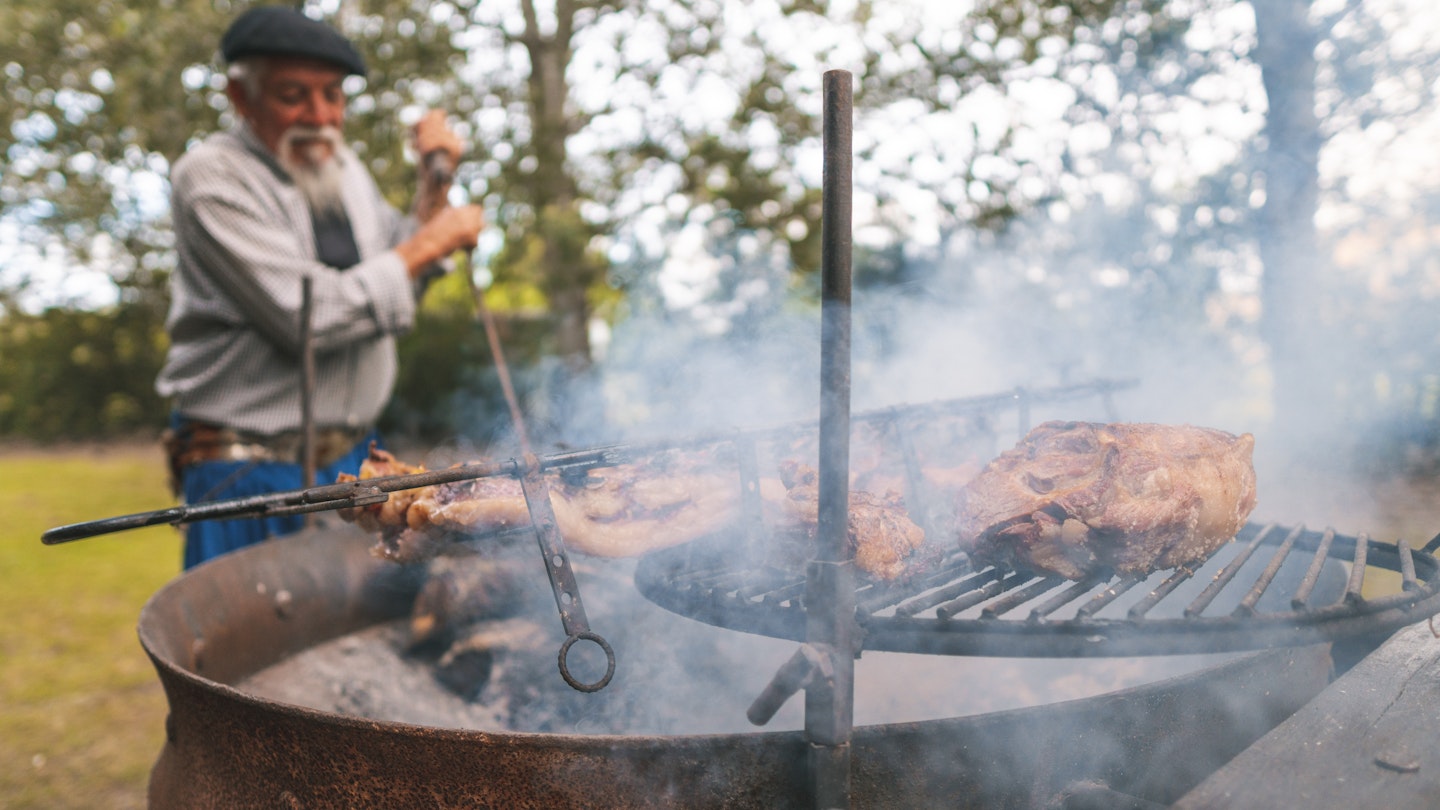While rich beef and sumptuous malbec are Argentina’s best-known specialties, there is more to the country’s food-and-drink scene than perfectly grilled steak and red wine. Due in part to the immigration of millions of Europeans to Argentina at the turn of the 20th century, the country brings together European traditions with a distinct South American twist. Notable examples include Italian-style ice cream, empanadas from Spain, and unique wines from French vineyards, along with yerba mate, a herbal tea that is native to South America.
Moreover, as Argentina is a vast country, each region boasts delicious specialties reflecting its heritage. Therefore, continue reading for a guide on how to savor every flavor across Argentina.
1. Savor grilled beef at an asado on an estancia
Argentinians are among the biggest consumers of beef in the world, and red meat is a vital part of the country’s culture. Grilling steaks is a tradition rooted in the mythologized gauchos who roamed the pampas (grasslands), tending to cattle and slow-roasting meat over an open flame in a custom ritualized as asado (barbecue).
Asados take on a traditional flair at an estancia (ranch), which can be reached via a day trip (día del campo) from major cities. For an immersive experience, consider an overnight stay.
2. Sip mate, Argentina’s quintessential hot drink
In parks and plazas, you’ll observe locals sipping mate, an infusion of yerba (a local, bitter herbal tea) with hot water served through a special metal straw called a bombilla. The gourd holding the beverage is also referred to as mate, and the act of drinking it is dubbed tomando mate (drinking mate).
The infusion is heated to 70–85°C (160–185°F) but never boiled; a thermos flask maintains the warmth for on-the-go enjoyment.
3. Tuck into an empanada, Argentina’s favorite snack
Oven-baked pastries with various savory fillings, empanadas are staple snacks in Argentina, often consumed during lunchtime. These delightful bites have regional variations, with spicy ground-beef empanadas typical in Salta and Jujuy, deep-fried versions originating from Tucumán, and lamb-filled empanadas found in Patagonia.
4. Get your meat-on-the-go fix at a parrilla food stand
For a quick protein hit, stop by a roadside mobile parrilla (grill) offering delicious grilled sausage sandwiches, known as choripán, or bodiola, a pork sandwich. These rustic food trucks serve generous portions of meat in thick crusty bread, complemented by self-service containers of chimichurri, a flavorful sauce made with garlic, parsley, oil, and vinegar.
5. Stop for afternoon tea in an elegant Buenos Aires cafe
In Argentina, it is rare to eat the main meal of the day before 9 PM. Consequently, many enjoy a merienda (afternoon tea) between 4 PM and 6 PM, usually consisting of a milky coffee accompanied by medialunas (croissants).
The late afternoon is ideal for visiting Buenos Aires’ traditional cafes, where sandwiches de miga (crustless sandwiches) and facturas (pastries) are served with flair by attentive waitstaff.
6. Drink Fernet with Coke, Argentina’s national party drink
In Argentina, the herbal Italian digestif Fernet-Branca is often enjoyed with ice and cola. This combination, known for its alcohol, sugar, and caffeine content, is a favorite among partygoers, particularly in the province of Córdoba, where the Fernandito cocktail stands out.
7. Cool off with ice cream in a traditional heladería
The rich legacy of Italian immigration is evident in Argentina’s exceptional gelato. It’s common for city center heladerías (ice cream parlors) to remain open late, providing perfect late-night treats. Popular flavors include sambayón and dulce de leche.
8. Share a picada, a tasting platter of cheeses and cured meats
A picada is a wooden board filled with an assortment of fiambre (cold cuts) and cheeses, usually served with bread and wine for sharing among friends. This communal dining style is a delightful way to enjoy a variety of flavors.
9. Treat yourself to an alfajor, Argentina’s national cookie
Alfajores are round cookies filled with dulce de leche caramel and often coated in chocolate or meringue. Each region has its own unique twist on this beloved treat.
10. Sample Argentina’s famous malbecs
Mendoza is recognized as Argentina’s premier wine region, particularly known for its robust malbecs. Other provinces like San Juan and Cafayate also produce excellent wines, including syrah and torrontés, respectively. Patagonia has emerged as a respected producer of pinot noir.
What can vegetarians and vegans eat in Argentina?
Although Argentina has been traditionally challenging for vegetarians and vegans, the dining scene is evolving. Most restaurants now offer meat-free options, such as pasta or gnocchi dishes. However, vegetarian meals may include eggs and cheese.
For vegan options, it’s advisable to check menus ahead of time, particularly in Buenos Aires, which boasts numerous plant-based eateries. Although outside the capital, vegan choices may be scarce, they are increasingly becoming available.
Food and drink festivals in Argentina
In a nation passionate about culinary experiences, Argentina hosts various food festivals, including:
- Fiesta Nacional de Asado (February): Enjoy grilled beef and lamb in Cholila, Chubut.
- Fiesta Nacional del Lúpulo (February): A celebration of hops at a lively festival in El Bolsón.
- Fiesta de la Vendimia (March): Wine-producing regions, including Mendoza, Salta, and Neuquén, celebrate the grape harvest with vibrant festivities.
- Fiesta Nacional de Chocolate (Easter): Chocolate lovers gather in Bariloche for a sweet celebration.
- Bariloche a la Carta (October): Relish Patagonia’s gastronomic specialties during this week-long food festival.
- Fiesta Nacional del Chivito (November): A folk festival in Chos Malal features barbecued goat dishes.
This article was first published on October 4, 2022, and updated on March 14, 2024.





